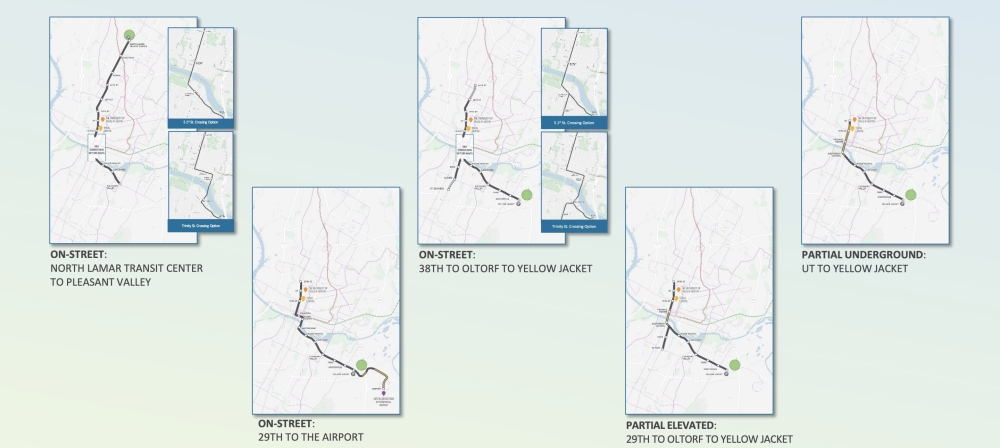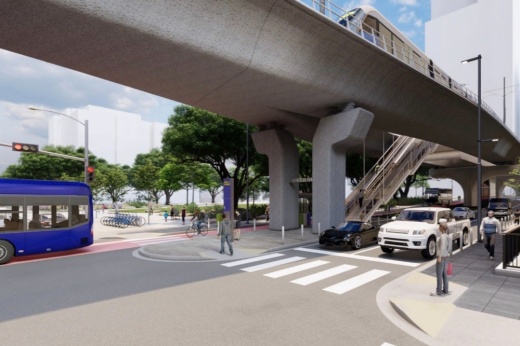Those new options on the table each represent a scaled-back version of the more extensive rail line plan promoted in the lead-up to Austin's November 2020 vote to fund the Project Connect transit system. That full plan is still expected to be realized down the line, but local officials and the Austin Transit Partnership—created in 2020 to oversee Project Connect—are now focused on laying out a shorter core system to serve as a foundation for future expansion while meeting] cost constraints.

More information and the opportunity to provide input on the five options is available from the ATP online through May 2. After that, the ATP will use the extensive public feedback collected this spring to put together a final proposal to fund and design over the years ahead.
Since the five light rail options were revealed March 21, the ATP said it has already received nearly 2,000 comments from community members sharing their views on the best path forward. An open house event March 21 brought in more than 700 attendees, while almost 8,500 people have viewed the ATP's virtual forum for the new designs.
As Austinites are getting more informed about Project Connect, planners said there is not yet an emerging favorite option in the community.
Lindsay Wood, ATP's executive vice president for engineering and construction, told City Council during an April 6 mobility committee briefing that residents do generally want to see some version of a rail project get underway despite their varied views on the new plan's scope and the best path forward.
Wood also told city officials that the debate over a link to Austin-Bergstrom International Airport; concerns about traffic and service reliability; and the choice among elevated, underground or at-grade stretches of track around downtown are among the issues that are top of mind for those commenting on the plans. And so far, there is no consensus on the airport connection, what grade rail should be built at or even which of the five options is preferred overall.
“The completely honest answer is feedback is very mixed,” she said. “Our community’s very well informed; they really are understanding the nature of the differences between options and are feeding that back to us. ... And it’s fairly split across the options.”
ATP staff also stressed they continue to solicit input with a focus on hearing from a representative slice of Austin.
“It’s not just the transit nerds that we need to talk to,” said Peter Mullan, ATP's executive vice president for architecture and urban design. “We need to talk to everyday, normal Austinites. So we’re working really hard to try to reach those members of the community where they are.”
A virtual informational event is scheduled for April 6, and Project Connect representatives are canvassing communities with engagement efforts such as bus stop visits to poll transit riders. The ATP is also available to visit with neighborhood groups and stop by community events upon request.
Laying out plans
With their differing features, each of the proposals is now estimated at a $5 billion price tag with the expectation that federal funding support—if secured—would roughly match that total. Wood said each option is as viable as the next with decisions on the details now up to the community and transit planners.
“Our criteria or our goal is that we want a system that people want to ride, a system that people want to use,” she told council.
A key decision, the possible airport connection, was one item highlighted during the April briefing as an example of the challenging trade-offs ahead for Project Connect.
Wood said residents seem to be split on the need to extend a rail line to the airport at the cost of other stations in Central and South Austin, a question community stakeholders and city leaders are also considering.
“I think about when I’ve traveled to other cities and it’s just really smooth and easy to figure out how you’re going to get to the downtown area. But that being said, I want to be mindful that the folks who are paying for this project are the folks who live, work, play here in Austin all the time,” Mayor Pro Tem Paige Ellis said. “I want to be mindful of the needs of the community and not only alleviating traffic congestion for people who are tourists here ... and also wanting to balance the needs of the people who will use it every day.”
While each of the ATP's five proposals is up for debate, there is a possibility that the final blueprint could merge elements of different plans if the community calls for it and the budget allows. There is also a possibility that more could be added to the first core rail plan if costs end up below expectations.
“No one scenario is meant to be the end all, be all,” said Annick Beaudet, the city's mobility officer for Project Connect.





